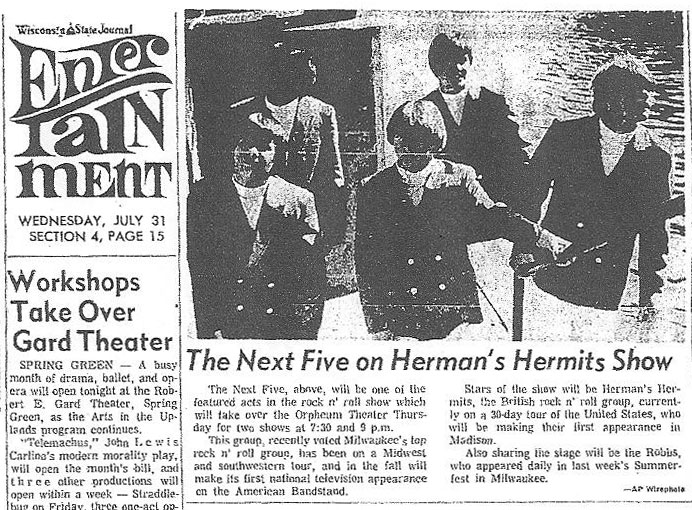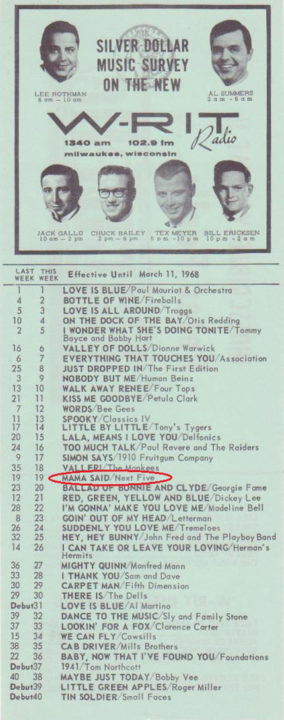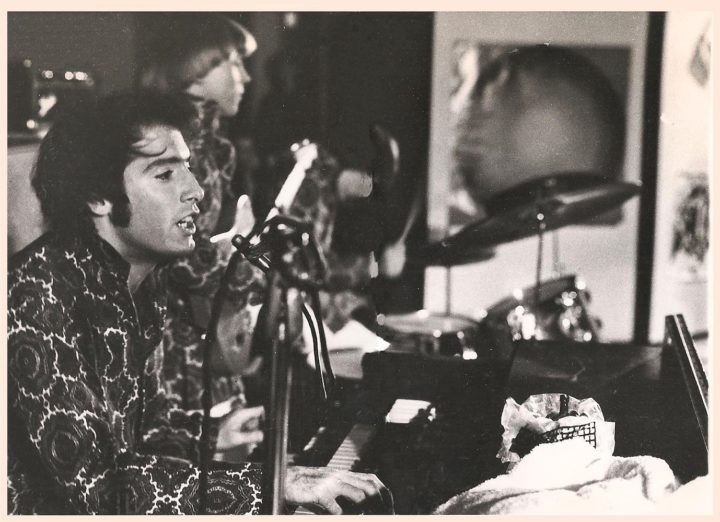
Tyler Tincknell (TT) – Interviewer
Eric Olson (EO) – Participant, lead vocalist and songwriter for the Next Five.
TT: How did you first get involved in music? Was the Next Five your first band?

TT: Garage bands began popping up all over the country in the mid-1960s for various reasons. What motivated you to be a part of the Next Five?
EO: My motivation to join the 4 piece band Steve already had was we were on the same page as to what we wanted to do, there was absolutely no question in my mind that this was the band I was looking for and they felt the same way about me joining them. Of coarse I had to wrestle our drummer (Tom “Ashbolt” Stewart) out in Steve’s back yard to prove my worthiness. We were an extremely tight group of guy’s back in the early day’s, not just musically but we were all close friends instantly. I spent the summer of ’66 practically living at Steve’s in Brookfield because I was from the south side of Milwaukee and that was a little distance away. I’ve always believed because we were so young we developed and grew together as one, and that was the magic of the “Next Five”.
TT: Wisconsin is not the first state people looked to as a “hot-bed” for garage music, but it actually produced some noteworthy groups like the Blues Boys, the Delcords, and, of course, the Next Five. What was the music scene like and did any local bands influence the Next Five’s style?
EO: There were a lot of bands locally just on the south side of Milwaukee alone, before I was even in a band I saw the “Savoy’s”, “El Demerons”, “Road Runners” and the “Legends” who I never met or saw but they had an album out called “Run To The Movies” with songs like “Lariat” and “Say Mama”, they were the generation before me and pre- Beatles and had a big influence on me. The first live act I ever saw was not a rock band, it was Concertina Millie at Mitchell Park in the very early 60’s, the energy level of that act blew me away, I was probably 11 years old at the time. When I joined the “Next Five” the influences had changed due to the British invasion.
TT: Speaking of the British Invasion, which band would you say was the Next Five’s main influence?
EO: I don’t think there was any one British band that influenced us, everyone in the band had their own personal influences, we were always trying to stay current and looked for songs that fit the band and had lots of vocals. Everybody was influenced by the Stone’s and Beatles, but we would only do one song by any given artist at a time. In those day’s we only did two 45 minute shows at every gig, 12 songs a set, 24 songs a night, always new songs coming in and old songs going out, most songs would last a month or maybe two. There were some songs that were album cuts and we could hang on to those a little longer. The DJ’S at WOKY and WRIT would give us a heads up on what was coming out so we could get a jump on the new stuff.

TT: What type of venues did the band perform at? What were some of the songs that would usually be featured?
EO: We played at high schools, proms, post proms, regular dances, colleges, teen centers, fairs and festivals, radio station events and a lot of CYO dances. Our manager Con Merten kept us booked solidly for three years straight. I remember going to children’s hospitals during Christmas to sing Christmas songs to kids. We did tv shows in Milwaukee, Chicago, Ohio. We did concerts with groups like the Rascals, Herman’s Hermits, shows with groups like Tommy James and the Shondells, the Royal Guardsmen, American Breed, Mitch Ryder and the Detroit Wheels, Moby Grape and many shows with Chicago bands like the New Colony Six, Shadows of Night and the Cryin’ Shames. In 1968 the first Milwaukee Summerfest was born and was produced by our manager (Con Merten) and Dee Robb from Wisconsin’s most successful rock band The Robbs, who Con also managed, that was a very memorable event. We would always do our own songs of coarse, but throughout the years we did songs like “Conquistador” Procol Harum, “Kids Are Alright” Who, “Hey Grandma” Moby Grape, “Rock and Roll Woman” Buffalo Springfield, “Black is Black” Los Bravos, “Saint Stephen” Grateful Dead, “Dear Mr. Fantasy” Kooper- Bloomfield and all the current hits at the time by groups like The Rascals, Hollies, Bee Gees, and even more poppy stuff by The Turtles and Lovin Spoonful.
TT: Talking with different artists, I find some tend to believe their greatest strength was found in their live performances. Would you say that was true about your band?
EO: Recording was always fun, but on live gigs you had an audience that fed you with energy. Kids would be jammed up in front of the stage and would rock out with the band and there is nothing that could compare to that. Doing TV shows was a sterile and technical environment where people just made sure your hair was in place, but by the end of a live gig your hair would be soaking wet and the sweat would be dripping down your face and you would be hyped up with adrenaline. I would have to agree with the other artists that there is nothing like live performances.
TT: I take it from the band’s discography, you were the main songwriter. What went into your composing process and was it a relatively easy task?


TT: I noticed all of your songs were featured on the B-side. Was there a reason for this or was it a coincidence?

TT: How would you describe the Next Five’s sound? How would you say the group’s sound matured over time?
EO: Like most teenage bands back then we did cover material in the beginning, and we did that better than most bands because that’s what got us off the ground and got our manager (Con Merten) and our producer (Paul Christy) interested in us. We not only developed musically but also our presentation matured very quickly because of constant live performances. But for me anyway, the essence of the “Next Five” came out on the recording of “Talk To Me Girl”, that was the real us, un-scrutinized, spontaneous, and no input from outside sources.
TT: I noticed you shared the bill with some very successful acts. What was your most memorable gig?
EO: I would have to say that very early on everyone in the band liked the Rascals, their still one of my favorite 60’s groups. So when Con Merten (our manager) informed us we would be opening up for them at the Milwaukee Auditorium along with the Robb’s who were also managed by Con, that was a big step forward for us. I can remember standing just feet away from drummer Dino Danelli while he was doing the show, the guy was incredible, the whole band was incredible. That has always stuck in my mind as one of the most memorable gigs we did with a major act.
TT: Although you hinted at it, could you elaborate further on how the Next Five secured a record deal?
EO: Our first record deal was with Destination USA Records out of Chicago, that was for “Little Black Egg” and “He Stole My Love”. They always wanted to meet someone in the band to make sure there was a band and not just a recording. I remember driving to Chicago with Paul Christy to have lunch with Bobby Monaco who worked with a lot of Chicago bands at that time and later discovered Rufus with Chaka Khan. Ironically, ten years later in the late 70’s I ran into him at the Roosevelt Hotel in Hollywood where he was the guest speaker at the song writers showcase I was attending, we spoke for a few minutes and I never saw him after that. Just before we signed our second deal with Wand Records out of New York for “Mama Said” and “Talk To Me Girl” they send a representative to Milwaukee to meet the whole band, unfortunately I cannot remember his name. We went downtown to a hotel where he was staying and actually had to sing for him in his room. We just brought a guitar and did the vocals for “Mama Said”, afterword he was convinced we were a band and we got the deal. Our third record deal was with Jubilee Records also out of New York for “Sunny Sunny Feeling” and “What’s That Melody” [released as by the Toy Factory], the representative was Steve Wax who was the national promotion rep. for Jubilee. We never did meet with him because he already knew we were an established band. However, I did talk to him many times on the phone regarding release date and distribution. As far as making the deals, the band never had much input, Paul took care of all the deal making that went on with all three of the record company’s we were signed to. Paul always seemed to do one shot deals in case one of the songs were to really take off, then he would be able to make a new and better deal. Back then all this information was hush, hush, we weren’t suppose to talk about any of this stuff, being all this happened a half century ago I think it’s ok now to discuss it.
TT: Were the band’s vocal harmonies well-rehearsed? I was intrigued with how well they flow with the lead vocals on “Little Black Egg”.
EO: Most of the time we would just have a guitar or use the organ and sing at rehearsals, it went without saying that everyone would know their musical parts. We were a vocal band on most of the material, some of the songs had maybe just a few other vocal parts, but if the vocals were tight the band was tight. After awhile, everyone seemed to know what part they would be singing.
TT: The Wand single sounds much more classical than most garage bands of the day. Did the Left Banke influence the band at all or was “Talk to Me Girl” a part of the Next Five’s own experimentation?
EO: The Left Banke was an excellent band, great harmonies, but we weren’t thinking of any other bands when we recorded “Talk To Me Girl”. Basically we weren’t thinking much of anything other than getting the song recorded in that 45 minutes left in the session. But again, that was the magic of that song, no time to think, just do. Spontaneity was the trick, I learned whatever you come up with first, it’s usually the best thing. Since then, I’ve found that you can try to keep finding different parts for a song and you end up going back to your first thought.
TT: You mentioned “Talk to Me Girl” is the best representation of the group’s sound. Where you guys given more studio freedom, and, if so, why was this the case?
EO: Back in the 60’s most producers didn’t really care what went on the B-side, the money was on the A-side. Being every Vinyl 45 had to have a B-side, most bands were just asked to put something together. Even on vinyl albums where there were usually 12 songs there was a lot of filler stuff, one or two songs would get featured and the rest barely got noticed. There were some exceptions to that rule on singles and albums, but not many. The B-sides were a place the bands could express themselves without much scrutiny from the record company or the producer, the only thing you needed to watch out for is that it was socially acceptable and none offensive.
TT: For all three singles, the Next Five also had three different record labels. Did this affect the group in any way or was that just a part of the business to you?
EO: All the record deals were pretty much just part of the business for us, we left everything up to Paul Christy and we trusted his decisions. Of coarse every band wanted to be signed to a major national label but that didn’t always happen. We were happy to be signed with Destination USA records out of Chicago for our first deal, it was a strong regional label that kick started many bands from the Midwest. From that, Paul was able to put together deals with Wand and Jubilee Records out of New York where at that time the music industry was centered.
TT: Did the records sell well? Which single was the most commercially successful?
EO: We were getting a good amount of airplay in Milwaukee from WOKY and WRIT and knew we were also getting it from smaller stations around the Midwest, and we found them on Jukeboxes. I don’t know exactly how many records were sold, we were never given that information. I did get royalties for writing the B-sides very early on, however I never received any for the “Mindrocker or the Pebbles albums. I would have to say “Mama Said” was our most successful record at the time. but it was the compilation albums that introduced “Talk To Me Girl” and “He Stole My Love” back in the 80’s.

EO: Yes, I have 3 acetates of 2 songs I wrote and our version of “Not Fade Away” . I haven’t heard those for a number of years now but I remember the quality was pretty bad, it was almost 50 years ago those acetates were made.
TT: Did the band have a chance to perform while in New York or in any other state for that matter?
EO: The whole band went down to Virginia to play some gigs because Paul our producer had moved down there, while Con our manager decided to move to New York to open an office with Denny Randell who was a song writer, producer and had co-written some of the early Four Seasons hits. I went to New York in Jan. ’69 to meet with them, the bottom line was the band would have to move to New York. While contemplating weather to relocate or not, Con and Denny had a falling out and Con moved to Los Angeles.
TT: Is it possible that the unreleased songs will be avaliable either online or on a compilation album?
EO: Probably not, the quality of those acetates are pretty bad and there’s not much that could be done to make them any better. Having said that, I just realized I was never in possession of the 8 track master tapes that were left at these studio’s, and neither was Paul Christy. I remember sometime in ’68 Paul Christy called us and asked if we would go to Chicago and record at a new studio that just went 8 track and they needed a band to get the bugs out of their new system, I didn’t have anything new written so we decided to record our version of “Not Fade Away” a song written by Buddy Holly. All I can remember is a guy named Cody who was the engineer and we talked on the phone and set up the time for the session. Ok, I just googled Stereo-Sonic Recording Corp. Cody and found out his name was Ed Cody, and there were some things about him. Numero Group profile – tribunedigital-chicagotribune If the 8 track master of “Not Fade Away” still exists it would now be with the Numero Group according to this 2 page article from the Chicago Tribune 2013, or in a storage locker. Apparently Cody kept acetates and master tapes of his sessions at Stereo-Sonic, ours would have been one of the first on their new 8 track machine. Wow, I never knew any of this or even thought of trying to find out until you asked me. I can’t remember where we recorded the other 2 songs I wrote “People” and “Sunday Dreamin” which are on the other acetate that has no label, I do know it was in Jan. or Feb. of ’69 and also done in Chicago. Earlier this year I talked to a record collector in Milw. who say’s he has an identical acetate of “People” and “Sunday Dreamin” which baffles me because I can remember there was only one made the day of our session. If either of those 8 track masters could be retrieved, then they could be digitized and made to sound like they could never have sounded back then.
TT: So was the falling out what lead to the Next Five’s disbandment? Did the band try to go on without them?
EO: Well the band lasted for 3+ years which was actually a pretty good amount of time for young teenage bands of the time. About half way through that time our drummer Tom Stewart left the band due to reasons I don’t remember, other then some misunderstandings with one or two of the other guy’s. Tom played the drums on “Little Black Egg” “He Stole My Love” “Mama Said” and “Talk To Me Girl”. That was when John Kruck joined for the duration of the band. John Played drums on “Sunny Sunny Feeling” “Whats That Melody” and all the songs on the acetates. Come the spring of ’69, Con our manager was settled in New York, Paul our producer was in Virginia and Steve Thomas our guitar player was heavily into med school. Gordy Wayne Olski the bass player and I were trying to keep the whole thing together while waiting for the release of “Sunny Sunny Feeling”. We held onto the bands farm house as long as we could but the money started to disappear. I can remember calling Steve Wax at Jubilee Records practically every day. When the record was finally released we found there was very little distribution and the radio stations only played it for a short time. Gordy and I jumped into another band and went to Charleston South Carolina to play at the Army Navy Club where we were introduced to playing 6 nights a week and 6 sets a night. After 3 weeks or so I left that band, jumped on an airplane and went back to Milwaukee where the realization of the demise of the Next Five became a reality.
TT: Do you feel the band accomplished everything it could and just ran its course or was there unfinished business? As a follow-up to that, was a studio album a possibility for the group?
EO: I think anybody in any band always feels that there was unfinished business in the end. Most bands didn’t get the opportunity of having someone like Con Merten for a manager and Paul Christy as a producer to guide them in the right direction. And yes, we kept bugging Paul about doing an album and he kept bugging us to keep writing.
TT: What did the other band members do after the Next Five that you know of? Do you keep in contact with any of them?
EO: After the band broke up Steve Thomas (guitar) went on to Med school and retired a few years ago, he now travels around the world, mostly to Caribbean and resides in Texas when he’s back in the states. I’ve had emails with him periodically just to reminisce about the old day’s and to catch up on what we’ve been up to. Gordy Wayne Olski (bass) went on to play in numerous bands and is still playing and resides in Wisconsin. I last talked to him a few years ago. Tom “Ashbolt” Stewart “1st drummer” also went on playing in different bands and he too is still playing and resides in Oregon. I have communication with him on Facebook. John Kruck (2nd drummer) went on to be a psychologist and is retired and living in Wisconsin. I talked to him a few years back.

The roster would not be complete without our road manager Randy “Spider” Schneider, who was as much a part of the band as the members. He drove the truck, hauled the Hammond organ and those Eros amps and set up all the gear to precision, not to mention the fact he was our protector. He is doing well and living in Wisconsin. I’ve been living in Los Angeles since 1977, I moved out here to go to work for the Robb’s at Cherokee Recording Studio’s in Hollywood where Con Merten was the General Manager. I’ve been playing with bands since I left Cherokee in 1980, and still playing now with a great bunch of guy’s around L.A.
TT: I have a copy of the Springdale ’73 album. Could you provide some background on the project and how it was released years later?
EO: Springdale was the name of the apartment complex in Waukesha Wisconsin where I was living back in 1973, and for no reason other then place and time I named that project “Springdale’73”. There was a time, 1972 when there was no such thing as affordable home recording. Springdale ’73 is an example of early affordable home recording using the newest technology of the time, the Teac 3340s and the SR-55 drum machine. For example, the Beatles recorded Sgt. Peppers on a Studer 4 track 1 inch tape machine, nearly the price of a house at the time. The Teac 3340s was a 4 track quarter inch tape machine, perhaps the price of a good used car. Every teenage band in the 60’s knew how hard it was to get a song recorded. You needed an established band, a producer, a manager, a recording studio and engineer, a good song, and lots of money, just to get 7 or 8 parts recorded together into a song. There was an actual turning point from the 60’s to now, and that was in 1973 when the Teac 3340S entered the commercial market. At an affordable price, the Teac gave you the same multi-track capabilities as those four track studios of the 60’s. Another new technology of the time was the Univox SR55 drum machine. Together, the Teac and drum machine started the home recording revolution – the complete self containment for songwriters of which is the norm today. In a nutshell, “Springdale ’73” isn’t about the songs anymore as much as it’s about one of the earliest (maybe the earliest) example of home recording using the Teac 3340s to it’s fullest extent.
TT: From what I read, you recorded 30 songs during this time. Will there a “Volume 2” to Springdale in the future?
EO: There were actually more like 40 songs that were recorded in a very short period of time back in ’73 and into ’74 using the electric drummer, but there isn’t any reason to release any more of those dated songs because it’s more about the technology and the technique of early home recording. At the time it was about making demo’s, now it’s simply about the tech part. I stopped using the electric drummer sometime in ’75 but used the Teac well into the 90’s. In 1980 I started writing for my band that was new wave. I set up a drum set in my house and I played drums on my recordings. Recently my publisher released 12 songs of mine on YouTube, one of those songs was from my 1980 recordings where it’s just drums, guitar and vocals, that was the way I would present the feel of the songs to the band.
TT: Do you recall any bands you recorded?
EO: I recorded at Cherokee with my band in 1980, I was never a studio musician there, most of their clients were the heavy’s, Rod Stewart, Neil Diamond, Barbara Streisand, Journey, Tom Petty, Cars, with producers like George Martin, Tom Dowd, and Roy Thomas Baker. I did do some 2nd engineering and worked in different capacities on sessions with War, Rod Stewart, Bill Quateman and others. My favorite was doing a 3 day session with the Beach Boys and their wives who were putting vocals on old Beach Boy reject songs just for the fun of it. It was like a family party they were having and they were all there including their kids, Mike Love was the only one who wasn’t there. When I started working at Cherokee they were in the middle of building studio 2 so I helped with that and then a remodel of studio 3. I can only think of 2 times I actually recorded with a client and that was clapping with Burton Cummings (Guess Who) on one of his songs and singing some back up thing with Livingston Taylor, James Taylor’s brother.
TT: When did you first notice the Next Five’s songs were being featured on compilation albums as notable as Pebbles and Mindrocker? Where you surprised the group was receiving that much coverage?
EO: I was living in Burbank in ’81 when a friend called and said another mutual friend in Chicago had just bought an album called Pebbles Vol 10 and “Talk To Me Girl” was first cut side A. I had another friend that was coming over to my house that day and I asked him if he could stop at Tower Records on Sunset to see if it was being sold there, well it was and he bought 2 of the albums and kept one, I still have the other one. That told me it was probably being sold in New York as well, I had no idea it was being sold all over the world. I didn’t know about the Mindrocker album with “He Stole My Love” on it for years, and I didn’t know the scope of the whole thing until the internet. In the last few years I found 5 of our recordings on 11 different comp albums, some legal and some bootlegged. Yes, it was a surprise. I did think we were long forgotten.
TT: Has anyone ever approached you with releasing a retrospective album that would compile all the Next Five’s recordings?
EO: No I haven’t heard from any record company about doing that, sounds like fun though. A lot of people don’t know this but you have to bake the tapes first or dehydrate them. I think I baked the Springdale ’73 tapes at 135 degrees for about or 4 hours. There are different ways of doing it and it takes the stickiness out of the old tape.
Closing statement by Eric Olson:
Tyler, on behalf of the Next Five and everyone affiliated with it, I would like to thank you, your magazine and your readers for taking interest in our experiences of 50 years ago, it was truly a magical time for us. We all went on to play in many other successful bands throughout the years and most of us are still at it today, but there was nothing like being a teenager in the 60’s and having those experiences. As of today, which is 8/12/16, I’m enjoying playing in a band for the last 2 years in Los Angeles with people who have had similar experiences, W. Michael Lewis on keyboards has been with groups such as Spirit, Mark Lindsay, Quicksilver Messenger Service and was on the Disco charts for 4 years, Terry Rangno on bass who had been a child actor and has been with the We Five for over 43 years, Glenn Stacey on sax and Tim Shea on drums, both have been pro musicians in Los Angeles for decades. We have a lot of fun taking long breaks at rehearsals and sitting around telling stories of days gone by.
Eric Robert Olson


Tyler, who are the Blues Boys?
I enjoyed the piece.
Gary, the Blue Boys were a garage band from a town called Jainsville, Wisconsin. They released the single “I Know” on Feature Records. I mentioned those groups because I thought there was a better chance Olson may recogize them.
OK, thx, Tyler. I do have that listing. In your article as posted, it shows as “Blues” instead of “Blue” (and I thought you were talking about Milw bands), so I thought you must be talking about some other band. (I’m the author of 2 bks on 50s-60s music from WI).
Eric sent me a CD years ago that included an alternate version of ‘Talk To Me Girl’ but he didn’t mention that here. I assumed it was recorded during the original sessions but I could be wrong.
Hi Mike, I know it’s you Mr. Dugo because you are the only one in the whole wide world that has a copy of that alternative version, I don’t even have one. That was done when I was digitizing the 45’s. For years after the original recording was made I would always hear that part in the song and regret I didn’t think of it at the session. When I put “Talk To Me Girl” on my 24 track digital recorder I realized I had 22 tracks left. I was writing new stuff at the time and was set up for doing vocals, so just for the fun of it I put that part on over the piano chorus simply because it was the first time in all those years I could do that. I never backed it up and I only made that CD you have of it. The only other time I put a part over a 2 track master was this year when my keyboard player (and publisher) W. Michael Lewis and I were editing songs the publishing company were releasing on YouTubes. I have a song called “Pink Champagne” that my old friend and bandmate Tom Fabre was going to put a sax intro and solo on, but around that time he had passed away and I just left it until W. Michael Lewis put a keyboard intro and solo over the 2 track master. Good to hear from you Mike, glad all’s well. https://www.youtube.com/watch?v=aktzEEKKD1s
Good hearing from you, too, Eric, and glad you are well. I really like the alternate version of TTMG. It might even be catchier than the original and, as I’ve told you, the original is an all-time favorite of mine. It’s great you’re still recording as well.
Hello. My name is Thomas Ashbolt Stewart. I am the original drummer with The Next Five. I played on the first two 45s we recorded, including Talk to Me Girl. I loved my time with The Next Five, and have been a professional drummer for 57 years. Currently I live and play in Todos Santos Baja SUR Mexico. Cheers! You can catch me on YouTube. Ashbolt Stewart BEATS WORKIN’ 2016
Enjoy very much reading the article and Eric surprised me with all his intricate knowledge and details which I have long forgotten, and fondly was reminded of. And happy to know that someone kept a record of many of the events, and share some of the same memories. Yes, what a magical time it was, and wouldn’t want to change anything about it. Yes I too was very sad to hear about our good pal Mark and his passing, and surprised to know that Eric, Gordy and Tom are still playing. I still play, but in my own little private recording studio while composing what comes to mind, when the inspiration comes up on me. That seems like how it is with a lot of musicians.
Maybe Eric and I will one day return up north and finish that road to his grandmothers lake. Great great fun that was, like all we did together as a close knit family, centered mostly at my father’s house as I lived alone with my father who enjoyed our company and cooked for us and we fondly nicknamed him Bobo, and famous for his hamburgers, lasagna and tacos.
Stephen Thomas MD
Those were the day’s my friend and yes, we thought they would never end. I do think it should be pointed out that Bobo, aside from being a great cook was an actual genius and had 12 patents for Allis- Chalmers on that first giant computer, if I’m not mistaken.
Steve! Great to read your comments and congrats on being a MD! Thanks for the great times!~Stuy Ashbolt Stewart
Stuy! My Great Scotts of Bobo the Great! I just now see your reply from 4 years ago… Shame on me! But, we already converse recently in 2020 and think of you often, and most fondly. You were my door to new things and breaking out of my world and shell, even if you knew it not. I was such a sad day for me when things went different paths. Yet, we shall always have what we worked so hard for back in the 60’s garage band days. We did not even know the history we were making at the time. And I still wonder about that silly guy that followed us around saying we had to be in some union. We were just 15, 15 or 17 years old and I had no idea what he was talking about. I thought maybe he was sweet on you or Eric, or maybe even Gordy… Ja Ja ja
Best to you in the Baja and the summers at the Victorian if you live or lease it, it still is yours. Wish to visit you while still in Baja, but you must be busy, as not hearing from you. God Bless my ole’ friend….
The Troll(Stephen/Steve Thomas MD)
I thought it was time for me to chime in. Really great to hear from DR. Steve. Eric and I talk about every 2 weeks. Always find new memories to talk about. Never gets old. Yes, those were the days. Eric said that I was doing well and living in Wisconsin. You play the hand that is dealt to you. After my divorce to my childhood sweetheart in 1967 and serving a total of 5 years with the US Army and reserves I hooked up with Eric and the rest of the guys. Had a total of 4 marriages. 4th marriage was for life or what is left. Ended up having 5 daughters ranging in age today from 30 years to 38 years. Have now been with my bride for going on 39 years. If i had a chance to go back and do the music thing all over again I would. Great times and great fun. Now all I have to do is get Eric back to Wisconsin for a visit and have Dr. Steve visit also. I do see Gordy every so often with the band he is with now. Wish I had a way to get in touch with John Kruck. Mark I will see someday I’m sure on the other side.
Forgot to mention that with having 5 daughters I now have a total of 11 grandchildren. Don’t need anymore.
Seńor Spider!
My Great Scotts of The Next Five loyal man, without we would have been in deep… Well, deep something… Ja ja ja Please let me know where you are and how you be doing my ole’ friend. Let me rev up my Firebyrd you liked more than I, as I recal. VaRoooom. Best, The Troll(Stephen Thomas MD)
I really enjoyed reading this interview w/ Eric! Like Steve,I ha forgotten a lot of details! That was So much Fun back in the day. I’m currently in 5 bands in Portland Oregon {been here 27 years}. I have a band called Bolt Upright which has 3 cds and I’ve recently releaseda recording titled ‘Ashbolt Stewart’ ‘Beats Workin’ which can be found at CD Baby. You can also check some vids on You tube. Peace and Pulsation to all. I sure miss Mark ‘the Monster’..he was wild!
I wish to update since my last comment here. I have since had extensive contacts and conversations with Eric, Ashbolt or Stewy Stewart, and Through Mark Lawler have John Kruck‘s landline, as he has never gotten into smart phones or computers. I’m stuck here in the Dominican Republic, arriving here on March 6, because of a family death, and planned to return the 26; but the crisis of COVID-19 has us stuck in this paradise in a nice luxury apartment a family member is not using until Christmas time, yet it’s a little nerve-racking being locked up seemingly, because of the strict government rules of a 5 PM curfew and anyone on the streets will be arrested. Also I am happy to announce that I have connected with Chris Connors, also known as Criss Dahlberg; and, we have video chatted on messenger a number of times for hours, and went over a lot of history, and we both filled in gaps of some history of those times if anyone is interested in some additional information, need only ask. Chris is one of the most talented musicians of the area, a virtuoso piano player classically trained, an incredible bass player and also a lead guitarist. Like myself learns songs by ear; but, he able to learn them faster than I could, but interestingly we use pretty much the same methodology. InnThe Next Five after adding Eric to our group, which was named “The What Four”, Eric was a welcome addition for an additional guitarist, which is what I really wanted, and another singer, so we could have three part harmony. This was just catching on at the time, and when managing to do it correctly sounded like magic. It was something evolving for a lot of garage band groups at the time. After teaching all the music parts, with the exception of percussion, I’d have the singers come over to my fathers home, Bob-o, the gourmet cook and the genius from Harvard University, as others have commented he was a walking encyclopedia Instant knowledge on any topic it seemed. To learn the vocal harmonies we would usually, in the morning, got together with some hot tea or coffee; and I with my acoustic guitar 🎸, got to work, painfully at first, to try to perfect our three part harmony as best we could. I would pick out which note to sing for each singer, with the transition of each chord. At first it was slow going, and maybe even painful and frustrating at first. . The notes were not always what you thought it might be. It was most challenging at times, yet, some times surprisingly easy, especially with songs that just fit the group. I would never trade the experience for anything else.
I’ll be connecting with John Kruck when I return, and continue my conversations with Eric, Ashbolt or Stewy, and Chris and hopefully Gordy down the road, if I can track him down. I’ve always wanted to visit the south of Baja Mexico, but the pictures and videos sent to me recently will just have to do, for now. But there’s so much to see out there in the world, and there’s just not enough time to even experience a small part of it. I traveled for a number of years to a number of countries, and just overwhelmed by the immensity of this planet and what it has to offer, to all and everyone. When I could, I would rent a place and live among the people on the fringes outside of the tourist routes, and really learn what the people were about. Got assaulted a few times, but learn to take the advice of the local people who were good in general, but there are bad folks out there just like here. And just being in American or Americano or gringo, can make you a target, so best not to go places alone.
Peace ☮️ & Best to All, Steve/Stephen Thomas MD